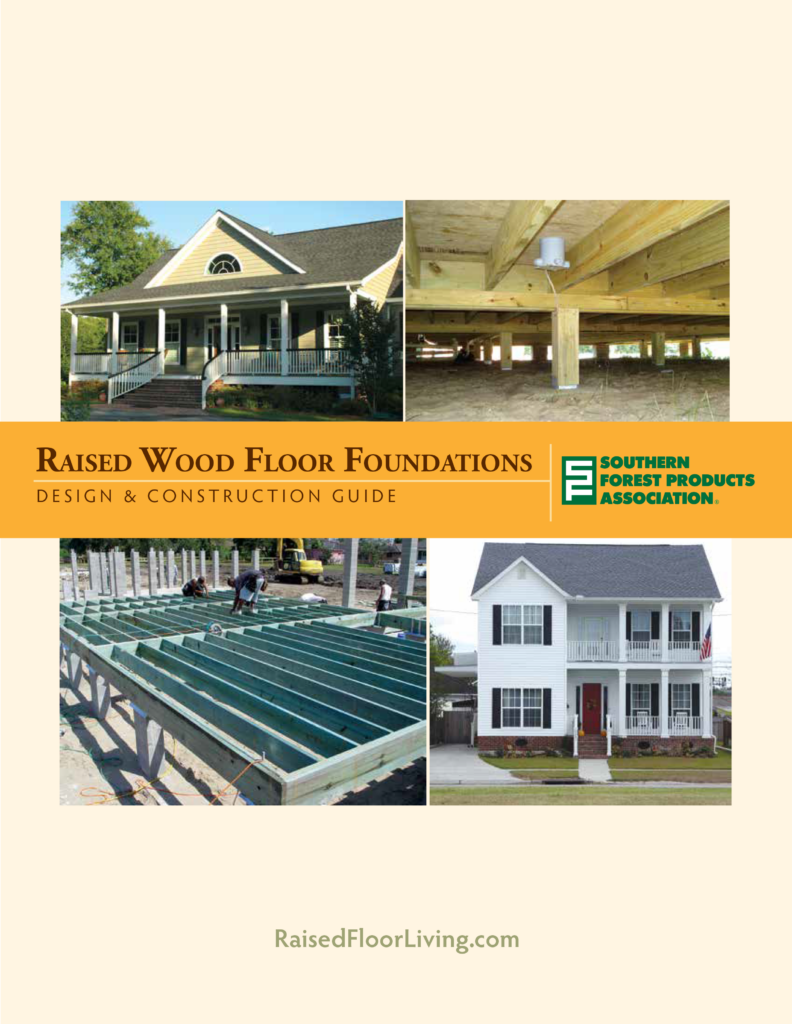Benefits and Advantages
RAISED WOOD FLOOR
Foundation Benefits and Advantages
American homes have been built on raised wood floor foundations since colonial times, and the aesthetic and practical reasons for building a raised home still apply today.
From improved ventilation and accessibility to flood resistance and sustainability, raised wood floor foundations offer a range of benefits and advantages over other types of home foundations.
The Sustainable Option
The raised wood floor foundation is a wise choice for sustainable home construction and community development.
Raised wood floor foundations support the floodplain management principle of “No Adverse Impact” on the rights of neighboring property owners and communities. Conversely, slab-on-fill developments alter the natural floodplain, leading to higher water levels and more frequent flooding.
Where slabs can smother the root systems of valuable trees, raised floor pier footers minimally disrupt roots and save trees that might otherwise be removed near a slab.
They also leave a softer environmental footprint compared to alternatives such as concrete and steel. Wood is the only renewable building material, whereas steel and concrete production use finite resources that require more energy and emit more pollutants. Additionally, wood contributes fewer greenhouse gases during the manufacturing process than its nonrenewable counterparts.
10 Additional Benefits
- Classic Style. Homebuyers are rediscovering the elegance a raised wood floor foundation design adds to a home’s look. The raised foundation functions as a pedestal and enhances curb appeal, regardless of architectural style.
- Uplifting Comfort. Raising the floor above the ground changes your perspective and makes you feel more secure. An ordinary view from the window becomes a vista. The subtle “give” of a raised wood floor system provides a more comfortable walking surface, putting less stress on your back, legs, and feet.
- Extended Living Space. Porches and decks are natural amenities for a raised wood floor system, adding usable outdoor living area to a home. Consider the charm and hospitality of a front porch, the pest-free privacy and comfort of a screened back porch, or outdoor cooking, entertaining, and relaxing on a spacious deck.
- Lifetime Foundation. Southern Pine is among the strongest of all softwoods, so you can expect a lifetime of strength, stability, and durability. And today’s modern pressure treatment processes add long-lasting resistance to decay and termite attack.
- Simple Foundation. Any foundation can settle, but the use of piers with a raised wood floor system makes leveling or repairs simple. With a raised floor foundation, leveling is as easy as jacking up the floor and adding shims. A raised wood floor foundation is also less susceptible to disruption from tree roots.
- Easier Home Improvement. Utility installation, maintenance, and modification – such as water, sewer, and electrical lines – is simplified with a raised wood floor foundation. Remodeling? Plumbing fixture modifications are more easily accessible, as is rerouting wiring for technology.
- Natural Insulator. Why live on the cold, damp ground? A properly constructed and insulated raised wood floor foundation isolates the home from potential moisture problems and provides a warm, comfortable walking surface.
- Reduced Flood Risk. Flooding is a potential risk for many homeowners. A raised wood floor system could be the solution by lifting your home’s foundation at or above base flood elevation and meeting building ordinances in flood-prone areas.
- Pest Control. Most pests are ground dwellers. With a raised wood floor foundation, your home is off the ground away from pests. For optimum protection against termites, pressure-treated and kiln-dried after treatment (KDAT) Southern Pine lumber is available.
- Flexible Landscaping. Landscaping looks best around the foundation of the home, by “grounding” the structure to the site. While root-severing slab construction often requires removing existing trees close to the structure, beautiful and energy-saving shade trees can be preserved near a raised wood floor foundation.
Builder Advantages
Satisfying the higher expectations of today’s homebuyers presents new challenges. With raised wood floor foundations, building professionals:
- Get Noticed. Raised wood floor home builders distinguish themselves from the competition by establishing a reputation for being green and progressive.
- Remain Competitive. The aesthetics and amenities of raised wood floor homes leave a positive impression on homebuyers, which may result in faster, more profitable sales. A raised wood floor foundation can also be a cost-competitive solution, especially in locations with elevation requirements, problematic soils, sloping terrain, or where extensive site preparation is needed.
- Stay on Schedule. Builders can avoid concrete slab delays related to poor weather, time-consuming forming and curing, trade scheduling problems, extra inspections, or hauling and compacting fill dirt.
- Increase Value. Building professionals who elevate with raised wood floors framed with strong, sustainable wood products create value for their clients. With the know-how to properly design and construct a raised wood floor system, building professionals can build homes faster and more cost effectively.
Check out our Raised Wood Floor Foundations publication, a comprehensive design and construction guide for using Southern Pine for raised wood floor systems.
Click below to learn more about:
